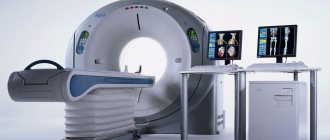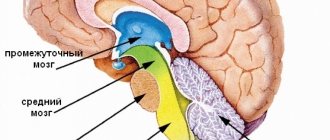The concept of pathology
Acute disseminated encephalomyelitis is a rather dangerous disease that affects the brain and spinal cord. If treatment is not started in a timely manner and in complex cases, death is possible.
It is believed that children are most susceptible to pathology. The average age at which the disease occurs in this category of people is 8 years. It can begin in infancy (3 months) and is most common before age 10 years. In adulthood and old age, the disease begins at 33.9 and 62.3 years, respectively.
There are primary and secondary forms of the disease. In the first case, it appears as a result of a viral infection. Secondary acute encephalomyelitis develops due to the appearance of complications after various ailments of a viral nature or after vaccination.
Prices for the diagnosis of acute disseminated disseminated encephalomyelitis
Acute disseminated disseminated encephalomyelitis has a similar clinical picture to multiple sclerosis, which is also an autoimmune disease. However, during the examination, the diagnosis of ADEM is established reliably. It is important to consult a doctor promptly at the first manifestations of symptoms of the disease. The sooner the diagnosis is made, the sooner treatment will begin. This way you can avoid serious complications.
At the Yusupov Hospital, a patient with suspected ADEM will receive assistance at any time of the day and on any day of the week, regardless of weekends. At the first examination, the doctor will refer the patient for tests. To diagnose ADEM, a lumbar puncture (examination of cerebrospinal fluid) and an MRI of the brain are used.
Cerebrospinal fluid test results for disseminated encephalomyelitis will show increased protein levels and an increased number of lymphocytes. An MRI will show large white matter lesions in various areas of the brain.
Classification
Based on the area affected by the disease, the following types of encephalomyelitis are distinguished:
- Disseminated myelitis. In this case, the functioning of the spinal cord is disrupted.
- Opticomyelitis and optoencephalomyelitis. They are characterized by a similar pathogenesis, with lesions of both the brain and spinal cord, as well as damage to the optic nerves.
- Polyencephalomyelitis. With this disease, the functioning of the nuclei of the cranial nerves located in the brain stem is disrupted, and the spinal cord (its gray matter) is also affected.
- Encephalomyelopolyradiculoneuritis. One of the most common such pathologies. In this case, disturbances in almost all components of the nervous system are observed.
Acute disseminated encephalomyelitis is most often diagnosed. This disease affects different parts of the brain and spinal cord. Pregnancy with acute disseminated encephalomyelitis proceeds as usual.
There is no uniform classification of this disease. In general, the following varieties are distinguished:
- brainstem encephalitis;
- cerebellite;
- neuromyelitis optica;
- optic neuritis;
- acute transverse myelitis;
- acute hemorrhagic leukoencephalitis.
With the first type, the following symptoms are observed:
- respiratory disorders;
- neuritis of the facial nerve;
- violation of the swallowing process.
Currently, myalgic encephalomyelitis is also distinguished. It develops after vaccination or an illness of viral origin. The following symptoms appear:
- muscle pain;
- disorders of the gastrointestinal tract;
- frequent mood changes;
- depression;
- the appearance of pain syndromes in joint areas;
- rapid fatigue after light exertion;
- chronic fatigue.
Prices for treatment of disseminated encephalitis
*The information on the site is for informational purposes only. All materials and prices posted on the site are not a public offer, defined by the provisions of Art. 437 Civil Code of the Russian Federation. For accurate information, please contact the clinic staff or visit our clinic. The list of paid services provided is indicated in the price list of the Yusupov Hospital.
*The information on the site is for informational purposes only. All materials and prices posted on the site are not a public offer, defined by the provisions of Art. 437 Civil Code of the Russian Federation. For accurate information, please contact the clinic staff or visit our clinic.
Causes
The reasons why the immune system begins to produce proteins against cells of its own nervous tissue remains unclear. However, it has been noted that encephalomyelitis most often develops after:
- viral infections, especially those accompanied by a rash (measles, rubella, chicken pox, herpes);
- administration of vaccines (post-vaccination encephalomyelitis);
- colds (flu, bronchitis, pneumonia);
- allergic reaction regardless of the cause;
- any situation accompanied by a decrease in immunity.
Possible consequences:
- complete recovery or mild neurological deficit;
- severe disabling defect;
- transition to multiple sclerosis (very often the onset of multiple sclerosis is mistaken for encephalomyelitis).
Symptoms of encephalomyelitis
The disease, as a rule, begins acutely, often with high fever, headaches, sometimes an excited state, and paresthesia. Subsequently, the neurological picture develops quite quickly; All parts of the central nervous system are affected, but in some cases the brain is more affected, in others - the brain stem and spinal cord. Of the cranial nerves, the II, III, VI and VII pairs are most often involved. Terrible, life-threatening phenomena occur in the first period of the disease when the trunk is damaged—impaired breathing and swallowing. Lower spastic paraplegia with impaired sensitivity along the conductor niknov type and urinary retention are common. Brown-Séquard syndrome is often observed. When the radicular-neuritic segment is involved in the process, tendon reflexes decrease or disappear. Cerebellar; extrapyramidal disorders are rare. One should keep in mind the possibility of fulminant forms of the disease with rapid involvement of the brain and brain stem, which leads to death in a short time. A mild increase in protein and pleocytosis are noted in the cerebrospinal fluid. The blood is often unchanged, but there may be mild leukocytosis (up to 13,000), a slight shift to the left, mainly in the acute and subacute period.
Some authors do not separate acute encephalomyelitis from acute multiple sclerosis. The group of encephalomyelitis also includes disseminated myelitis, when the process is limited only to the spinal cord. Clinically, several lesions are observed within the spinal cord (cervicothoracic and thoracic localization) with motor and sensory disturbances.
After the acute period, complete or partial recovery gradually occurs. However, persistent residual effects may be observed, most often in the form of atrophy of the optic nerves and paresis of the limbs.
Diagnostics
A preliminary diagnosis is made based on an analysis of specific symptoms and a thorough history taking, in which attention is paid to provoking factors (acute viral disease, vaccination). To clarify the diagnosis, magnetic resonance imaging is mandatory. In the case of acute disseminated encephalomyelitis, multiple, often confluent, diffuse, asymmetrical lesions are found in the brain and spinal cord.
Classification
There are primary and secondary encephalomyelitis. The most common etiological factor of acute primary encephalomyelitis is a viral infection. The occurrence of secondary encephalomyelitis is usually considered as a complication of common infectious diseases or is a post-vaccination complication.
Based on the predominant damage to the process, the following types of disease are usually distinguished:
- Encephalomyelopolyradiculoneuritis is the most common form of encephalomyelitis, which is characterized by damage to almost all parts of the nervous system;
- polyencephalomyelitis is characterized by damage to the nuclei of the cranial nerves of the brain stem and the gray matter of the spinal cord;
- optoencephalomyelitis and neuromyelitis optica are forms of the disease similar in pathogenesis, which are characterized by a combination of manifestations of optic neuritis with signs of damage to the brain and spinal cord;
- with disseminated myelitis, damage to the spinal cord is noted at its different levels.
Patient Actions
If this diagnosis is confirmed, urgent treatment must be prescribed, because encephalomyelitis can have very serious consequences.
Treatment of encephalomyelitis
Corticosteroids or ACTH. In case of respiratory problems - resuscitation measures. In the residual stage - rehabilitation therapy. Muscle relaxants (mydocalm) and other drugs that improve cerebral circulation are used as drug therapy.
Complications
Complications of encephalomyelitis are often pneumonia, cystitis, pyelonephritis, and bedsores.
Prevention of encephalomyelitis
Avoid hypothermia and overheating during vaccination. Do not drink alcohol when vaccinated. People who are vaccinated should be exempted from night shifts and physical reloads.
The central nervous system is the brain and spinal cord. The defeat of each of them has its own name. And their defeat at the same time bears the combined term of disease names. This is the disease that will be discussed in this article.
Causes
To date, they have not been fully studied. It is still unknown for what reasons the body begins to produce proteins aimed at fighting the nervous system.
The progression of the disease is noted according to the following:
- colds;
- allergy;
- reducing the body's reactivity;
- introduction of certain types of vaccines;
- viral infections, primarily those that cause various skin rashes: rubella, chickenpox, herpes;
- traumatic brain injuries.
Signs
The disease begins quickly. Symptoms of acute disseminated encephalomyelitis are divided into general cerebral and focal. The first include the following:
- decreased intelligence;
- weakening of memory;
- disturbance of consciousness;
- epilepsy attacks.
In their absence, the diagnosis of “acute disseminated encephalomyelitis” is doubtful.
Focal symptoms manifest as multiple brain lesions. Basically they are combined as follows:
- oculomotor disorders;
- extrapyramidal;
- cerebellar;
- pyramidal.
Only based on these signs can only a highly qualified doctor make a correct diagnosis.
The two categories of symptoms of acute disseminated encephalomyelitis described above appear within 7-14 days, after which the clinical picture becomes less pronounced. As the disease progresses, disturbances in the peripheral nervous system may appear. A condition such as polyneuropathy may appear.
Different symptoms may appear depending on which part of the brain is affected.
Initial signs may appear already during an infectious disease that causes encephalomyelitis, with asthenia and an increase in body temperature. These include:
- tingling sensation in the legs - quite rare;
- disturbances in the gastrointestinal tract;
- increased excitement, sometimes replacing lethargy;
- runny nose, pain and sore throat;
- drowsiness;
- an increase in body temperature is possible, although not necessary;
- headache;
- general malaise.
If the brain is affected, the following signs of the disease may be observed:
- the occurrence of a convulsive syndrome similar to an epileptic seizure;
- paresis of limbs;
- paralysis;
- speech disorders.
When the spinal cord roots are damaged, the following symptoms are observed:
- pain syndrome spreading along the spinal column, reminiscent of the clinical manifestations of lumbago;
- the functioning of the pelvic organs deteriorates: there may be a delay in urination, bowel movements, or the opposite picture in the form of incontinence;
- pain and temperature sensitivity of the body decreases;
- trophic changes in the epidermis appear.
When the optic nerve is damaged, the following symptoms are observed:
- pain appears in the orbit, which gradually increases, especially when making sudden movements with the organs of vision;
- a “veil” forms before the eyes;
- vision deteriorates.
The main differences between acute disseminated encephalomyelitis and multiple sclerosis are as follows:
- unlike the latter, autoimmune reactions to myelin antigens do not have a chronic course and are limited to one exacerbation;
- the structure of the lesions in both diseases is the same, however, the inflammatory dynamics and edema are more pronounced in the disease under consideration, oligodendrocytes are less affected.
Encephalomyelitis (ADEM) - symptoms and treatment. Consequences and diagnosis
Acute disseminated encephalomyelitis , or disseminated encephalomyelitis (orem transcript) is an inflammatory lesion of the central nervous system, which is of autoimmune origin.
Pathology is the outcome of an infection or occurs against the background of immunization. To cope with the disease, you need to visit a specialist in a timely manner. Accurate diagnosis is important , on which the effectiveness of treatment will depend .
The etiology of the disease has not been thoroughly studied today. Researchers to this day speculate and argue why the human body’s defense system begins to produce proteins aimed at combating nervous tissue.
It was possible to obtain information under what circumstances the disease begins to develop intensively:
- as a result of traumatic brain injury;
- against the background of encephalomyelitis viruses, accompanied by a skin rash (herpes, chickenpox, etc.);
- when using certain types of vaccines;
- reducing the body's reactivity;
- allergic reaction;
- ARVI.
Classification of encephalomyelitis
According to international standards for the classification of diseases, encephalomyelitis is divided into the following categories:
- viral encephalomyelitis;
- tropical static paraplegia, expressed by paralysis of the upper limbs;
- bacterial form of diseases;
- myelitis, which is diagnosed in the absence of information about the cause of the disease.
Some materials provide information that the separation can be primary or secondary in nature. In the first case, damage to the tissues of the central nervous system is implied.
In case of secondary damage, they talk about the consequences of injury, the occurrence of a reaction to a vaccine, or infectious encephalomyelitis.
Symptoms of encephalomyelitis
Autoimmune encephalomyelitis can be classified into two main groups. These are focal and cerebral signs of encephalomyelitis. The first manifestations represent the general extent of brain damage.
General cerebral symptoms serve as a serious reason for diagnosis. Among them are epileptic seizures, confusion, and cognitive disorders. The latter are manifested by the occurrence of memory problems and weakening of mental abilities.
Both groups make themselves known within 14 days. After this time, the intensity of the clinic decreases.
There may be signs of dysfunction in the peripheral nervous system.
In general, patients complain of the following symptoms:
- nausea;
- headache;
- muscle soreness;
- dizzy states;
- speech disorders;
- paresthesia;
- fever.
The symptoms of encephalitis in children and adults are no different; the disease progresses the same in both age groups.
Diagnosis of encephalomyelitis
Determining the correct diagnosis is not a difficult task. As a rule, doctors prescribe magnetic resonance imaging of the brain for patients. Pathological changes can be easily visualized on the monitor. If necessary, the doctor will refer the patient for a lumbar puncture.
When collecting spinal contents (lumbar puncture), attention is paid to how it flows out. If this occurs in the form of a jet, then they speak of the presence of a pathological process.
There are indirect markers that indicate autoimmune encephalomyelitis. Doctors pay attention to the high level of protein content.
Orem is a diagnosis that requires a repeat MRI for encephalomyelitis 6 months after treatment.
Treatment of orem
The fundamental method of therapy for acute disseminated encephalomyelitis is the use of steroid medications. Over time, it is recommended to minimize the dosage of medications.
This therapeutic technique has its own side reactions, expressed in weakening of the immune system. Therefore, immunoglobulins are prescribed, and sometimes antibodies are removed from the blood.
Treatment is complex and consists of the following measures:
- taking antiviral drugs;
- B vitamins;
- medications to relieve brain swelling;
- nootropics and neuroprotectors.
Due to the fact that acute encephalomyelitis affects the most vital organ, patients may require resuscitation measures: ventilation, connection to a cardiograph, etc.
During the recovery stage, the patient undergoes massage, therapeutic exercises, and stimulation of the cerebral cortex through magnetic impulses.
Treatment of encephalomyelitis with folk remedies is not advisable. It is useful to supplement your therapeutic regimen with tinctures and herbs if your doctor has prescribed them to you. It is unwise to practice independent treatment with folk remedies without adequate therapy; this will lead to a disastrous result - death.
Consequences of orem
If you ignore the clinic, unforeseen consequences may arise in acute disseminated encephalomyelitis. The majority of patients recover with proper action, but 30% have neurological problems with orem, which can lead to disability and even death.
Consequences of disseminated encephalomyeditis: decreased visual acuity, paresis, difficulty swallowing.
As for the progression of the disease during pregnancy and childbirth, the fair sex significantly increases the risk of exacerbation if they have been ill. It is important to undergo repeated examinations.
It is important to know: encephalomyelitis is a disease that can develop into multiple sclerosis.
Prevention of encephalomyelitis
Preventing the development of a disease is much easier than curing it. Therefore, follow these simple principles:
- when making vaccines, avoid hypothermia and overheating;
- do not drink alcohol while getting vaccinated;
- do not overload yourself physically;
- play sports and strengthen yourself;
- Do not go to places with large crowds of people during an epidemic.
Orem is a serious diagnosis that requires special attention. You should not delay treatment, otherwise bitter complications cannot be avoided.
Source: https://xmedicin.com/rasseyannyiy-entsefalomielit/
Diagnostics
To identify the disease, MRI is performed in acute disseminated encephalomyelitis using contrast. Features of the disease are easily detected by a doctor on an image or screen. In the FLAIR and T2 modes, asymmetric hyperintense foci are determined that have poor outlines in both the white and gray matter of the brain, and in the second they may not be expressed. They can be small (up to 0.5 cm), large (more than 2 cm) and medium (having intermediate values). Sometimes there are large confluent lesions with perifocal edema, which cause displacement of surrounding structures. The optic thalamus may also be involved. In large areas of inflammation, hemorrhages are observed. The contrast agent accumulates in the lesions with varying intensity. They can be detected in the spinal cord in a small number of cases, not exceeding 30%. After identifying the disease and treating it, patients are recommended to undergo a repeat MRI after six months. A decrease in areas of demyelination or their complete disappearance indicates a correct diagnosis and the exclusion of multiple sclerosis.
In addition, diagnosis, if necessary, can be performed by performing a lumbar puncture. In this case, the patient is placed on his side with local anesthesia. A needle is inserted between the lumbar vertebrae to withdraw a small amount of cerebrospinal fluid, which is analyzed. If the disease is present, a large number of lymphocytes will be found in it.
Additionally, perimetry, ophthalmoscopy, and consultation with an ophthalmologist may be prescribed.
When making a diagnosis, it is imperative to take into account the presence in the clinical picture of signs of cerebral syndrome or encephalopathy. The latter includes patient complaints of nausea, vomiting, headaches, while disturbances in behavior and consciousness are noted - from stupor and drowsiness up to the development of coma of varying degrees.
Causes of acute disseminated encephalitis
The precursor to disseminated encephalomyelitis is a viral or bacterial infection that is accompanied by high fever.
ADEM is autoimmune in nature, when the immune system does not adequately respond to the disease. As a result of damage to the body by a virus or bacteria, elements of the immune system begin to attack foreign substances. ADEM often occurs against the background of an infection of the upper respiratory tract. Other causes that can cause disseminated encephalomyelitis include measles, rubella, mumps, chickenpox, herpes virus, Epstein-Barr virus, cytomegalovirus, and various bacteria. Neurological symptoms occur one or more weeks after the first episode of fever. The patient develops:
- constant headaches,
- drowsiness,
- fatigue,
- difficulty swallowing.
Movement disorders and speech disorders occur. Impaired consciousness can lead to coma. Disseminated encephalomyelitis may be accompanied by epileptic seizures, hallucinations and mental disorders.
A distinctive feature of the development of ADEM is the rapid increase in neurological symptoms. It all starts with headaches and fever, and general cerebral symptoms quickly develop. After a couple of days, during the examination, lesions in the white matter of the brain will be clearly visible.
With timely treatment, disseminated encephalomyelitis has a good prognosis. The disease can be treated with medication, and following all the recommendations of the attending physician will minimize possible consequences. The Yusupov Hospital employs professional neurologists, doctors of science, who have extensive experience in treating such diseases.
Treatment of disseminated encephalomyelitis should be carried out in a hospital setting to monitor the therapy being performed and immediately respond to changes in the patient’s condition. The Yusupov Hospital provides patients with comfortable rooms with all amenities. The patient is provided with qualified medical care around the clock, all diagnostic and therapeutic procedures are performed. The Yusupov Hospital is located near the center of Moscow, in a quiet, picturesque place on Nagornaya Street.
To treat ADEM, drug therapy is used, which includes:
- corticosteroids;
- immunoglobulins;
- plasmapheresis;
- nootropics;
- amino acids;
- vitamins.
The drugs are aimed at accelerating the healing process, relieving symptoms and restoring metabolic processes in the brain. In some cases, the patient may need rehabilitation using physical therapy. The rehabilitation clinic of the Yusupov Hospital has created all the conditions for effective and comfortable treatment of patients.
With timely and adequate treatment, the prognosis for disseminated encephalomyelitis is favorable. Most often, complete recovery occurs without residual symptoms. Sensitivity disorders and decreased vision remain less common. Lesions may persist in the brain and are visible on MRI. In the future, a relapse of the disease or transformation into multiple sclerosis is possible.
When visiting the Yusupov Hospital, the patient receives a full range of medical services and qualified assistance. You can make an appointment and get advice from specialists by phone.
Acute disseminated encephalomyelitis (ADEM, a synonym for the name of this disease - acute disseminated encephalomyelitis) is a relatively rare disease of the nervous system, similar to multiple sclerosis, which is known to many.
It is believed to be caused by viruses (less commonly bacteria), as well as the use of certain vaccines (extremely rare).
With ADEM, one of the sheaths of nerve fibers, the myelin, is destroyed, so this disease is classified as demyelinating.
The clinical signs of this disease are very diverse. The onset of viral encephalomyelitis is usually acute and manifests itself:
- a sharp rise in temperature;
- manifestations of brain damage - headache, vomiting, depression of consciousness up to coma;
- signs of meningitis;
- epileptic seizures (not always);
- focal symptoms, including paralysis, paresis, disturbances of tactile sensitivity and sense of balance;
- impairments of cognitive functions (deafness, distortion or absence of speech, memory disorders);
- disturbances in vital functions (respiratory arrest, cardiac arrest), leading to death (rare).
The symptoms of the disease are variable, so additional studies are prescribed to clarify the diagnosis.
During a spinal tap, the resulting fluid reveals a slight increase in protein levels and an increase in the number of lymphocytes (pleocytosis). A general blood test reveals an increased number of leukocytes and ESR.
If necessary and technically possible, serological reactions are carried out to clarify which microorganism provoked encephalomyelitis.
Of the instrumental studies, MRI (magnetic resonance imaging) is the most informative for diagnosing encephalomyelitis. Using this method, you can confidently localize lesions in the brain and spinal cord. Computed tomography for ADEM is not informative enough; other research methods are not used at all.
In modern medicine there are no truly effective antiviral drugs.
Considering the data on the autoimmune factor in the development of ADEM, it is treated primarily with large doses of corticosteroid hormones, which are administered intravenously.
Treatment should begin as early as possible, since every hour of delay increases the risk of residual neurological impairment and worsens the prognosis.
In the absence of methylprednisolone, it is possible to use drugs with a similar mode of action - dexamethasone, as well as corticotropin, which causes the body to produce its own hormones that act similarly to drugs.
Studies show the high effectiveness of the combined use of hormonal agents and immunoglobulins, as well as plasmapheresis.
In severe cases, pulse therapy with cyclophosphamide is used, an anti-cancer drug that can suppress the body's immune response to the disease.
Treatment of such forms of pathology is carried out in special hospital conditions in compliance with all rules for infection prevention.
The prescription of antibiotics is not only justified, but also mandatory for encephalomyelitis caused by bacteria (borrelia, mycoplasma). In parallel, for all forms of ADEM, symptomatic treatment of all existing syndromes is carried out:
- intracranial hypertension is reduced with diuretics (diuretics);
- in case of breathing problems, the patient is transferred to life support;
- for convulsions, strong sedatives are prescribed;
- carry out correction of water and electrolyte balance;
- treat a secondary infection if it appears against the background of the main disease.
The consequences of infectious encephalomyelitis in children and adults may differ. The child's body has great self-healing abilities, which is why persistent disorders of motor and sensory functions at a young age are rare.
There may be a decrease in sensitivity in the areas of nerve innervation, the centers of which have been affected by infection, impaired motor functions, memory, sleep, balance disorders, hearing impairment, vision, etc.
In rare cases, persistent post-traumatic epilepsy develops.
The exact cause of ADEM is unknown. However, most researchers agree that the disease is most likely the result of an abnormal response of the immune system to an infection or other trigger. Many researchers suggest that acute disseminated sclerosis may represent an abnormal immune reaction directed against the body's own tissues (autoimmune diseases).
In autoimmune disorders, the body's natural defenses (eg, antibodies, lymphocytes) actively work against substances that are perceived as foreign (antigens), causing them to attack healthy tissue for unknown reasons.
Other reasons are:
- upper respiratory tract infections;
- viruses;
- measles;
- mumps;
- rubella;
- chicken pox;
- Epstein-Barr virus;
- cytomegalovirus;
- herpes simplex virus;
- bacterial agents, such as tuberculosis bacteria;
- vaccination.
Vaccination
The development of ADEM after vaccination is not uncommon. Some vaccines cause an understandable process of infection of the white matter of the brain by active pathogens. For example, vaccination against smallpox using a live vaccine can cause a similar reaction. There are also known cases of encephalitis developing after vaccination against whooping cough and influenza.
Organ transplant
Another cause of ADEM is organ transplantation. Although this procedure is associated with the risk of an inflammatory process in the brain, this risk is very small. The more actively the child’s vaccination schedule and preventive measures in adulthood are followed, the lower the likelihood of any form of encephalitis.
According to statistics, from 50 to 70% of cases of ADEM are caused by a viral or bacterial infection, accompanied by symptoms of damage to the upper respiratory tract. From the moment of contact with a carrier of the infection and infection until the appearance of the first symptoms of acute disseminated encephalitis, 7 to 14 days pass, sometimes more than a month passes between the moment of infection and the appearance of the first symptoms, the maximum interval is 3 months from the moment of infection.
During the development of the disease, the body reacts in a specific way to the infection. Instead of destroying bacteria (viruses) foreign to the body, the immune system begins to attack its own beneficial cells. Inflammation occurs in the organs of the central nervous system, and nerve cells are also damaged, which then react incorrectly to stimuli.
Symptoms of acute disseminated encephalitis appear within 7 to 90 days after infection. The main symptoms are as follows:
- fever;
- nausea;
- vomit;
- headache;
- confusion;
- limb weakness;
- ataxia;
- sensory changes (numbness, tingling in feet and hands);
- ataxia;
- optic neuritis;
- vision problems;
- temperature increase;
- sinusoidal temperature jumps (from normal to high temperature);
- epileptic seizures;
- convulsions;
- prolonged headaches;
- headache in the morning and evening;
- drowsiness;
- difficulty trying to swallow food;
- coma;
- ghosting;
- ataxia;
- cranial nerve palsy;
- hallucinations;
- speech disorders;
- nystagmus;
- ophthalmoplegia;
- mental disorders;
- neuritis;
- dysesthesia;
- visual impairment.
Variants of the course of the disease
Currently there are three of them:
- monophasic;
- returnable;
- multiphase.
In the first case, a single episode of neurological impairment occurs and the disease subsequently resolves.
In the recurrent variant, the same symptoms or even their increase are observed 3 months after the onset of the first attack or 30 days after the end of taking corticosteroids.
The multiphase course is characterized by the fact that after the same period of time new complaints and symptoms appear.
Goals of therapeutic treatment
The patient must first of all know that acute disseminated encephalomyelitis is curable. But to achieve this, you need to carry out appropriate treatment, which should be aimed at:
- identification and treatment of infections, which prevents its transformation into multiple sclerosis; every six months you need to check for their presence by doing control immunograms;
- monitoring the immune state of the body to select optimal antiviral therapy;
- the maximum possible restoration of the functioning of brain areas affected by inflammation by stimulating remyelination;
- elimination of the aggressive behavior of immunity to the central nervous system with normalization of the first response to the entry of foreign microorganisms into the body.
Treatment of encephalomyelitis
Basic therapy is carried out with anti-inflammatory steroid drugs. Medium or high doses of Prednisolone can be used depending on the patient’s condition, with a gradual reduction.
Corticosteroid therapy is carried out for 2-5 weeks. To prevent side effects, intravenous immunoglobulins are prescribed. Immune antibodies and immune complexes can be removed from the body using plasmapheresis, which is carried out in difficult cases.
Treatment of acute disseminated encephalomyelitis is aimed at eliminating the causes of the disease. For this purpose, antiviral agents belonging to the group of interferons are prescribed.
Sometimes, with a bacterial etiology of the disease, antibiotics may be prescribed:
- "Kefzol";
- "Gentamicin";
- "Ampioks".
For the treatment of acute disseminated encephalomyelitis, accompanied by rheumatism, bicillin therapy is prescribed.
Symptomatic therapy is mandatory. Hemodynamic restoration, artificial ventilation, and resuscitation measures can be performed.
To prevent cerebral edema, the following drugs are administered:
- "Furosemide";
- "Magnesia";
- "Diakarb."
How to eat when diagnosed with acute disseminated encephalomyelitis? Severe dysphagia should be accompanied by tube feeding.
If urinary retention occurs, a catheter is inserted into the bladder. If intestinal paresis is observed, then enemas are done. If seizures are present, anticonvulsants are prescribed.
For the treatment of neurological disorders, anticholinesterase drugs are prescribed: Proserin, Galantamine, vitamins B and C.
For convalescence, absorbable drugs are used: Cerebrolysin, Lidazu.
Treatment of disseminated encephalomyelitis may be accompanied by the use of nootropic drugs:
- "Nootropil";
- "Ginkgo biloba".
Doctors can also prescribe neuroprotectors: Mexidol, Semax.
Motor activity is restored through exercise therapy and massage. Transcranial magnetic stimulation is also performed.
In case of exacerbation of the disease, treatment is carried out in a hospital setting. In this case, potent medications are prescribed.
Treatment of acute disseminated encephalitis
Vaccination
Organ transplant
The immune response is also responsible for demyelination, a process in which myelin fibers break down. These fibers are conductors of nerve impulses and thereby isolate impulses from each other and from other neurons (without myelin fibers).
- vomit;
- refusal of food;
- tearfulness;
- imbalance;
- loss of coordination;
- visual disturbances.
Such treatments include:
- corticosteroids;
- immunoglobulin;
- plasmapheresis.
Corticosteroids are considered the main drugs for the treatment of encephalitis. They help relieve symptoms and are considered basic therapy. The methods of administration, forms, dosages and treatment schedule are determined only by the doctor; in addition, corticosteroids tend to cause side effects.
Intravenous immunoglobulins are used when the patient cannot tolerate corticosteroids or they do not provide adequate relief for symptoms.
IVIg solution is a concentrated solution of antibodies that are extracted from the blood of healthy donors. Immunoglobulins are used to treat various autoimmune diseases because they have properties that neutralize the effects of autoantibodies.
Plasmapheresis is used to treat patients who do not respond to other forms of therapy. However, its use is not widespread.
Plasmapheresis is a method of removing unwanted substances (toxins, metabolic waste) from the blood. Blood is drawn from the patient, which is then separated from the plasma, and the patient's plasma is replaced with clean plasma. The blood is then mixed with plasma and administered to the patient.
Folk remedies
They can be used, but not during an exacerbation. They are mainly used during the recovery phase to maintain the functioning of the nervous system. The following recipes are used:
- Ball-headed Echinops. Take 3 tbsp. l. fruits, pour 250 ml of boiling water, place in a thermos, in which they infuse for 12 hours. The resulting infusion is drunk in small portions throughout the day. Treatment is carried out for two months.
- Mumiyo. 5 g dissolved in 100 ml of water. Take 1 tsp three times a day. 1 hour before meals three times a day.
- Onions with honey. The onion is peeled and chopped using a grater. The juice is squeezed out, after which it is mixed with honey. Use 1 tsp three times a day. for a month.
They should not be the main method of treatment. Used with the permission of the attending physician.
Main differences in the course of the disease in children and adults
Previous vaccination or previous infectious disease most often causes acute disseminated encephalomyelitis in children. At the beginning of the development of the disease, they often experience fever, which is absent in adults. Children are characterized by encephalopathy syndrome, which occurs in a severe form. In adults, it manifests itself in mild to moderate form with the possible appearance of hallucinations and delusions.
Children often exhibit signs of meningoencephalitis with the occurrence of ataxia; in adults there are motor and sensory deficits, and radicular syndrome may be observed.
When performing MRI, lesions in children are located in the spinal cord, brainstem, cerebellum, cortex and region of the basal ganglia; periventicular lesions are rare. In adults, the latter are often observed; there is an increase in protein and pleocytosis.
Children go through the recovery process quite quickly. At the same time, adults have a long period of hospitalization with the same recovery.
The mortality rate in children is around 5%, in adults - around 8-25%. Young patients have the most favorable outcome of the disease. Adults are often characterized by a gross residual deficiency.
Consequences of acute disseminated encephalomyelitis
The disease can be characterized by a severe course, resulting in the formation of bulbar disorders, which can be fatal.
The consequences of acute disseminated encephalomyelitis may result in residual neurological deficits, leading to profound disability. Age-related changes are a risk factor for repeated exacerbations and transformation of the disease into multiple sclerosis.
Some patients acquire persistent symptoms, manifested in the form of sensory disturbances, visual impairment and paresis.
Inflammation in disseminated encephalomyelitis
Disseminated encephalomyelitis is a not very common pathological condition in which inflammatory changes occur in both the central and peripheral parts of the nervous system. The development of this disease is based on various autoimmune reactions, which lead to acute inflammation.
A specific point in this pathology is that there is a reversible destruction of the myelin sheaths covering the nerve fibers. In most cases, properly selected therapy leads to complete recovery of the patient.
Only a small number of people are subsequently left with permanent neurological impairment, for example in motor or sensory functions.
According to statistics, in two thousand and eleven, only fifty cases of this disease were recorded among adults in Moscow. It is worth noting that this disease can occur in absolutely any age group.
However, it has been noted that children are somewhat more susceptible to its development.
Despite the fact that children are more likely to experience disseminated encephalomyelitis, its course is significantly milder among them.
And although such inflammation often does not lead to serious consequences for the sick person, in rare cases it can cause severe bulbar disorders followed by death.
In addition, it is believed that this pathological process can sometimes contribute to the formation of multiple sclerosis.
As we have already said, the development of disseminated encephalomyelitis is based on autoimmune disorders, leading to diffuse inflammatory changes in the nervous system.
It is assumed that this inflammation in the vast majority of cases is triggered by previous viral diseases. Examples include herpes or enterovirus infection, influenza, and so on.
In the event that the clinical manifestations characteristic of this pathology arose precisely after an infection, they speak of the primary nature of disseminated encephalomyelitis.
In other words, the launch of autoimmune reactions was caused by the administration of a vaccine, for example, adsorbed pertussis-diphtheria-tetanus vaccine (DTP vaccine).
In addition, it is believed that the secondary form of disseminated encephalomyelitis is sometimes associated with exposure to bacterial infectious agents.
The main predisposing factor for the occurrence of such inflammation is a reduced level of immune defense. A decrease in immunity can occur against the background of severe stress, hypothermia, bad habits, existing chronic diseases, and so on. A number of scientists express the opinion that there is a hereditary predisposition to the occurrence of this pathological process.
From a morphological point of view, this inflammation is characterized by diffuse destruction of the myelin sheaths in the structures of the central and peripheral nervous system.
Due to demyelination, the affected nerve structures lose their functional activity, which contributes to the formation of neurological disorders with varying degrees of severity. The important thing is that often, under the influence of therapy, the myelin sheaths can be completely restored.
Almost seventy percent of people who have had disseminated encephalomyelitis do not have any further complaints.
The clinical picture of disseminated encephalomyelitis, first of all, consists of various disorders of consciousness. In severe cases, the sick person may even fall into a coma. In the vast majority of cases, symptoms such as attacks of dizziness and headaches, severe nausea accompanied by vomiting, increased sensitivity to bright light and loud sounds, as well as agitation followed by apathy are present. Neurological symptoms increase quite quickly and reach their peak in just a few days.
The presence of focal symptoms must be noted. They may vary for each individual patient and directly depend on which part of the nervous system was affected.
Some people report having motor and visual disturbances. Also characteristic is the addition of sensory function disorders.
In addition to the acute course, such a pathological process can occur in a recurrent form. In the recurrent form, similar symptoms occur three or more months after the initial episode. However, new lesions are not detected by magnetic resonance imaging.
This disease requires a comprehensive neurological examination in conjunction with an ophthalmological examination and lumbar puncture. However, the leading role in diagnosis is given to magnetic resonance imaging, which will identify foci of destruction of the myelin sheaths.
Treatment for this inflammation primarily consists of the administration of high or medium doses of systemic glucocorticosteroids.
As the clinical picture subsides, a gradual reduction in dosage is carried out. The treatment plan can also be supplemented with antiviral drugs and various symptomatic medications.
After the onset of convalescence, nootropics and neuroprotectors are indicated.
It is quite difficult to talk about the prevention of this disease. The only recommendation is to prevent infection and timely treatment of various viral diseases.
Forecast
The acute period of the disease lasts for 1.5-2 weeks. In most cases, the prognosis is favorable. Up to 90% of patients undergo a monophasic course. In the majority of patients (70-90%), symptoms are subject to regression within six months after the onset of the disease, which is associated with remyelination processes.
The prognosis worsens with recurrent and multiphase flow options. In this case, the acute form of the disease becomes chronic, and multiple sclerosis begins to develop.











